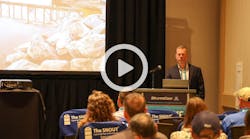Hydroseeding With Native Seed Mix for Erosion Control
Native seed mix is becoming increasingly popular in hydroseeding projects. When native grasses and plants spring up after a successful hydroseeding project, the plants blend in with neighboring vegetation. The success of any erosion control project depends on many factors, including site, budget, and season. In this article we’ll examine two successful projects where native seed mixes were hydroseeded.
Bridge Replacement and Difficult Access
Bridge replacement projects are gaining attention not only across the United States, but also just over the border in Canada. The Sarnia Road bridge replacement took place in the fall of 2011 in London, Ontario. JK Landscape Inc., also based in London, used a Bowie Imperial 3000 Hydro-Mulcher to revegetate the site.
“The Sarnia Road Bridge replacement had its own unique challenges. The areas to be hydroseeded were adjacent to a new bridge over an existing rail line. The terrain consisted of steep slopes and swales leading down to the rail line,” explains John Kochanowski, owner of JK Landscape. “This was a late fall dormant seeding scenario, and erosion control was the main focus of the project. The soil had to be maintained for the winter period of approximately four months to protect the rail line and keep the slopes from causing a rail accident.”
It the early planning stages, the hydroseeding techniques considered were not extensive.
“However, after consulting with the city engineers and with the help of our industry partner, Quality Seeds, a more comprehensive plan was formulated,” according to Kochanowski. “Both Terra-Tubes, for water management and slope interruption, and Enkamat turf reinforcement mats were installed in the most problematic areas. Flexterra HP-FGM was substituted for regular cellulose mulch to ensure that the erosion control would function properly over the winter months. Along with a custom native seed mix and cover crop, a plan was developed to prevent soil or sediment loss reaching the rail line. Silt fencing and straw bales were used to augment the erosion control measures.”
Experience with Bowie equipment influenced the decision to use it on this project.
“JK Landscape Inc. has used Bowie machines since the company’s inception. Reliability and power were the basis for our choice,” notes Kochanowski. “Bowie equipment has consistently delivered the reliability that we require to complete our work efficiently. Today’s construction industry demands equipment and services that deliver the goods on time and on budget. Bowie fits the bill.”
The project, which cost approximately $35,000, may have used a complex web of solutions to achieve its goal, but its purpose was clear and straightforward from start to finish.
“The revegetative goal for this project, although daunting, was really quite simple: prevent soil and sediment from reaching the rail line,” says Kochanowski. “The site itself was challenging, with steep slopes and swales. However, the combination of Flexterra HP-FGM, Enkamats, Terra-Tubes, excellent native seed mixes, and the Bowie equipment proved to be a winning combination. The following spring resulted in excellent germination and no soil loss.”
Residential Protection: Combining Proven Methods
The need to protect residential areas from soil erosion also played a role in hydroseeding planning at a 25-acre site in Carlsbad, CA, in 2014.
In a region where wild areas are becoming scarce because of continuing development, revegetating an area damaged by wildfire is, of course, a sensitive process.
“This is a unique ecosystem called a coastal sage scrub community and chaparral,” explains Rob McGann, president of HydroPlant Hydroseeding Inc., based in San Marcos, CA. “It’s pretty widely distributed here in southern California. The fire burnt so intensely there was no vegetation left.”
“[The homeowners association] put in a claim to their insurance for it,” says McGann. “We went in in two different phases, a total of 10 working days.”In October 2014, the company began hydroseeding work on the open-space areas of the site that burned adjacent to local homes.
Timing of the project was crucial.
“Part of the reason they timed the work for the fall was to take advantage of the rains,” says McGann. “It’s all non-irrigated. We’re leaving it up to Mother Nature.”
The company applied Spokane, WA-based Fiber Marketing International’s wood fiber mulch; Ranchester, WY-based Rantec Corp.’s SpecTac binder; and a coastal sage scrub mix for the revegetation, which is expected to take approximately three to five years.
“The access was extremely challenging because there are canyons,” says McGann, noting that workers could approach the area using a hose. “They’re not very deep, but they are extreme. Some are so sheer you can’t even walk on them, so you need a nozzle on the top.
“In applying the hydraulic matrix on the soil, in some areas ash can be six to eight inches deep. It’s not easy dragging a hose and walking through it. They guy doing the spraying has a knack for it. It’s a visual and a sensory thing. He can see when the ash is settling down. He might have to go over a given area four or five times.”
Unexpectedly, a rainstorm struck right after the treatment.
“In the areas untreated ashflow there was some runoff so they decided to go in and do those areas too,” says McGann. “It’s germinating as we speak. We got it 100% covered.”


